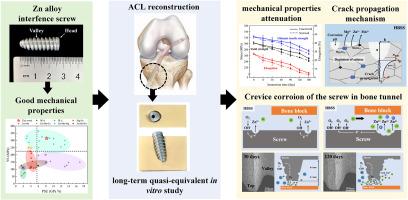A long-term quasi-equivalent in vitro study of high-strength Zn alloy interference screws for anterior cruciate ligament reconstruction
IF 18
1区 医学
Q1 ENGINEERING, BIOMEDICAL
引用次数: 0
Abstract
Biodegradable Zn alloy interference screws are promising for anterior cruciate ligament reconstruction. However, previous in vitro studies not only predominantly focus on short-term (≤30 days) immersion, but also neglect influence of crevice corrosion in bone tunnel. This study develops a Zn-0.45Mn-0.2 Mg alloy with yield strength of 288.3 MPa, ultimate tensile strength of 325.4 MPa and elongation of 26.3 %. The alloy is fabricated into screws, inserted into polyurethane bone blocks and immersed in Hank's balanced salt solution for 180 days. The alloy degraded at a corrosion rate of 0.07 mm/y, with its yield strength and elongation eventually decreasing to 229 MPa and 4.3 %, respectively. Second phase detachment during long-term corrosion reduces alloy's surface fracture toughness (KIC) and increases stress intensity (KI) at corrosion pits. This causes premature fracture of the alloy (KI > KIC) and a larger decrease in the alloy's ductility (70 %) than that in strength (30 %). Crevice corrosion of the screws originates deep within the bone tunnel and spreads outward over time. Accumulation of Cl− ions exacerbates corrosion severity in the narrow thread tops of the screws. This study provides a foundation for quasi-equivalent in vitro studies of Zn alloy implants, and highlights the necessity of developing ductility-attenuation-resistant Zn alloys.

高强度锌合金干涉螺钉用于前交叉韧带重建的长期准等效体外研究
生物可降解锌合金干涉螺钉在前交叉韧带重建中具有广阔的应用前景。然而,以往的体外研究主要集中在短期(≤30天)浸泡,忽视了骨隧道缝隙腐蚀的影响。该合金的屈服强度为288.3 MPa,抗拉极限强度为325.4 MPa,伸长率为26.3%。这种合金被制成螺丝,插入聚氨酯骨块中,在汉克的平衡盐溶液中浸泡180天。合金的腐蚀速率为0.07 mm/y,屈服强度和伸长率最终分别降至229 MPa和4.3%。长期腐蚀过程中的第二相脱落降低了合金的表面断裂韧性(KIC),增加了腐蚀坑处的应力强度(KI)。这导致合金过早断裂(KI >; KIC),合金的延展性(70%)比强度(30%)下降更大。螺钉的缝隙腐蚀起源于骨隧道深处,并随着时间向外扩散。Cl−离子的积累会加剧螺钉窄螺纹顶部的腐蚀程度。本研究为锌合金植入体的准等效体外研究奠定了基础,并强调了开发抗延展性衰减锌合金的必要性。
本文章由计算机程序翻译,如有差异,请以英文原文为准。
求助全文
约1分钟内获得全文
求助全文
来源期刊

Bioactive Materials
Biochemistry, Genetics and Molecular Biology-Biotechnology
CiteScore
28.00
自引率
6.30%
发文量
436
审稿时长
20 days
期刊介绍:
Bioactive Materials is a peer-reviewed research publication that focuses on advancements in bioactive materials. The journal accepts research papers, reviews, and rapid communications in the field of next-generation biomaterials that interact with cells, tissues, and organs in various living organisms.
The primary goal of Bioactive Materials is to promote the science and engineering of biomaterials that exhibit adaptiveness to the biological environment. These materials are specifically designed to stimulate or direct appropriate cell and tissue responses or regulate interactions with microorganisms.
The journal covers a wide range of bioactive materials, including those that are engineered or designed in terms of their physical form (e.g. particulate, fiber), topology (e.g. porosity, surface roughness), or dimensions (ranging from macro to nano-scales). Contributions are sought from the following categories of bioactive materials:
Bioactive metals and alloys
Bioactive inorganics: ceramics, glasses, and carbon-based materials
Bioactive polymers and gels
Bioactive materials derived from natural sources
Bioactive composites
These materials find applications in human and veterinary medicine, such as implants, tissue engineering scaffolds, cell/drug/gene carriers, as well as imaging and sensing devices.
 求助内容:
求助内容: 应助结果提醒方式:
应助结果提醒方式:


